The Effects of Ethnically Congruent Music on Eye Movements and Food Choice—A Cross-Cultural Comparison between Danish and Chinese Consumers
Abstract
1. Introduction
- Eastern music would lead to more fixations on Eastern foods, and Western music would similarly lead to more fixations on Western foods.
- These fixation patterns could congruently predict the choice of the food, consistent with the “gaze bias theory” of visual attention and choice [38].
- 3.
- Chinese participants would have more revisits compared to Danish participants.
2. Materials and Methods
2.1. Participants
2.2. Visual Stimuli
2.3. Auditory Stimuli
2.4. Design and Procedure
2.5. Data Analysis
2.5.1. Eye-Tracking Metrics
2.5.2. Statistical Analysis
3. Results
3.1. Choice
3.2. Eye-Tracking
3.2.1. Fixation Count—Chinese Participants
3.2.2. Fixation Count—Danish Participants
3.2.3. Revisit Count—Chinese Participants
3.2.4. Revisit Count—Danish Participants
3.2.5. Relationship between Food Choice and Eye Movements
3.3. Follow-Up Questions
3.3.1. Food Items
3.3.2. Music Excerpts
4. Discussion
Limitations
5. Conclusions
Author Contributions
Funding
Acknowledgments
Conflicts of Interest
Appendix A
| Food Item | Image Number | Food Category |
|---|---|---|
| Steamed meat buns | 460 | Eastern |
| Fried dumplings | 519 | Eastern |
| Fried rice | 396 | Eastern |
| Fried noodles | 487 | Eastern |
| Noodle soup | 533 | Eastern |
| Noodles with pork | 422 | Eastern |
| Pork over rice | 526 | Eastern |
| Fresh spring rolls | 405 | Eastern |
| Stir fried vegetables | 524 | Eastern |
| Mapo tofu | 551 | Eastern |
| Chicken wrap | 666 | Western |
| Spicy chicken wrap | 124 | Western |
| Greek salad | 9 | Western |
| Quinoa salad | 668 | Western |
| Risotto | 105 | Western |
| Grilled sandwich | 95 | Western |
| Pizza | 357 | Western |
| Cheeseburger | 292 | Western |
| Fishburger | 8 | Western |
| Mashed potatoes | 352 | Western |
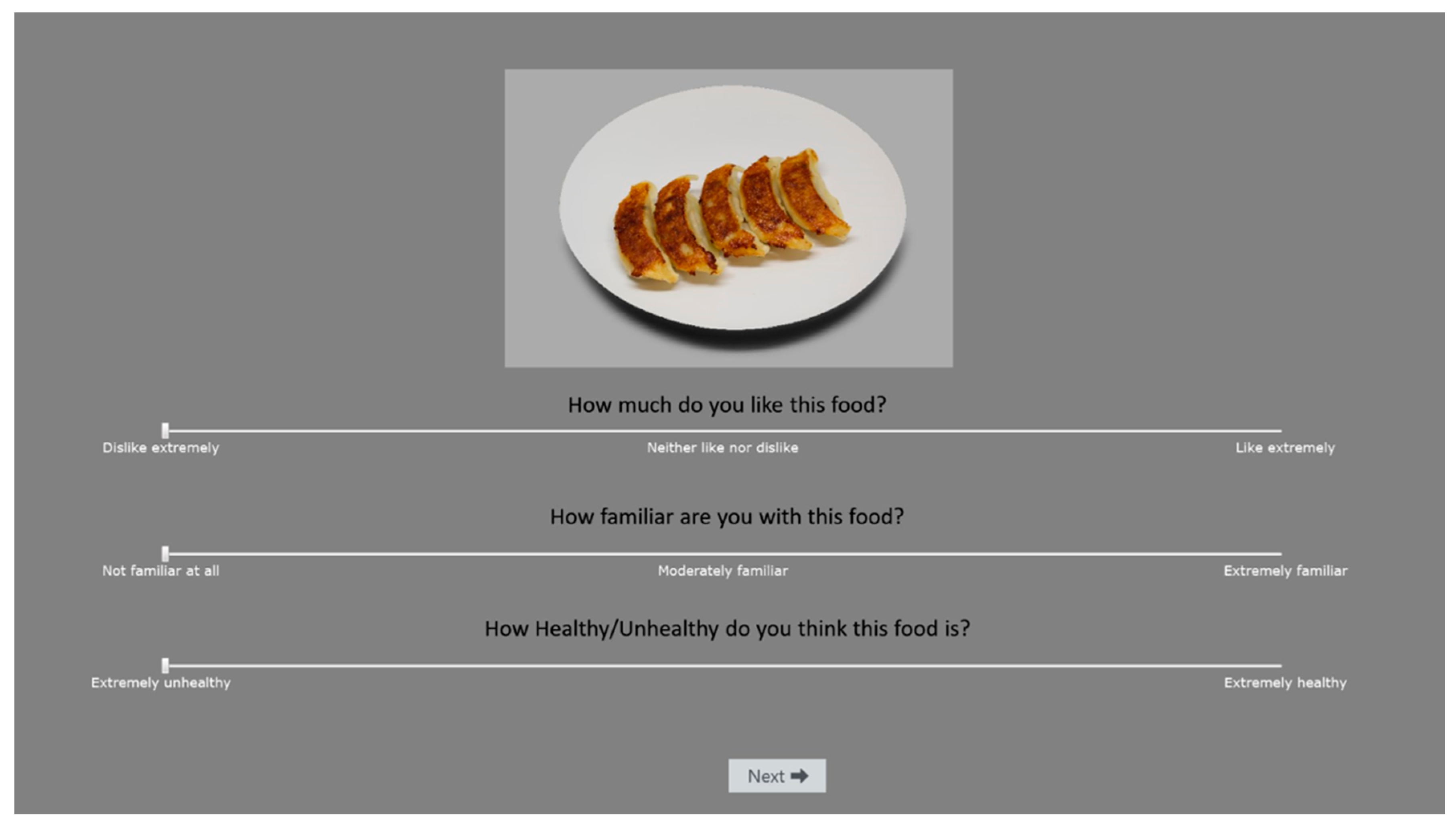
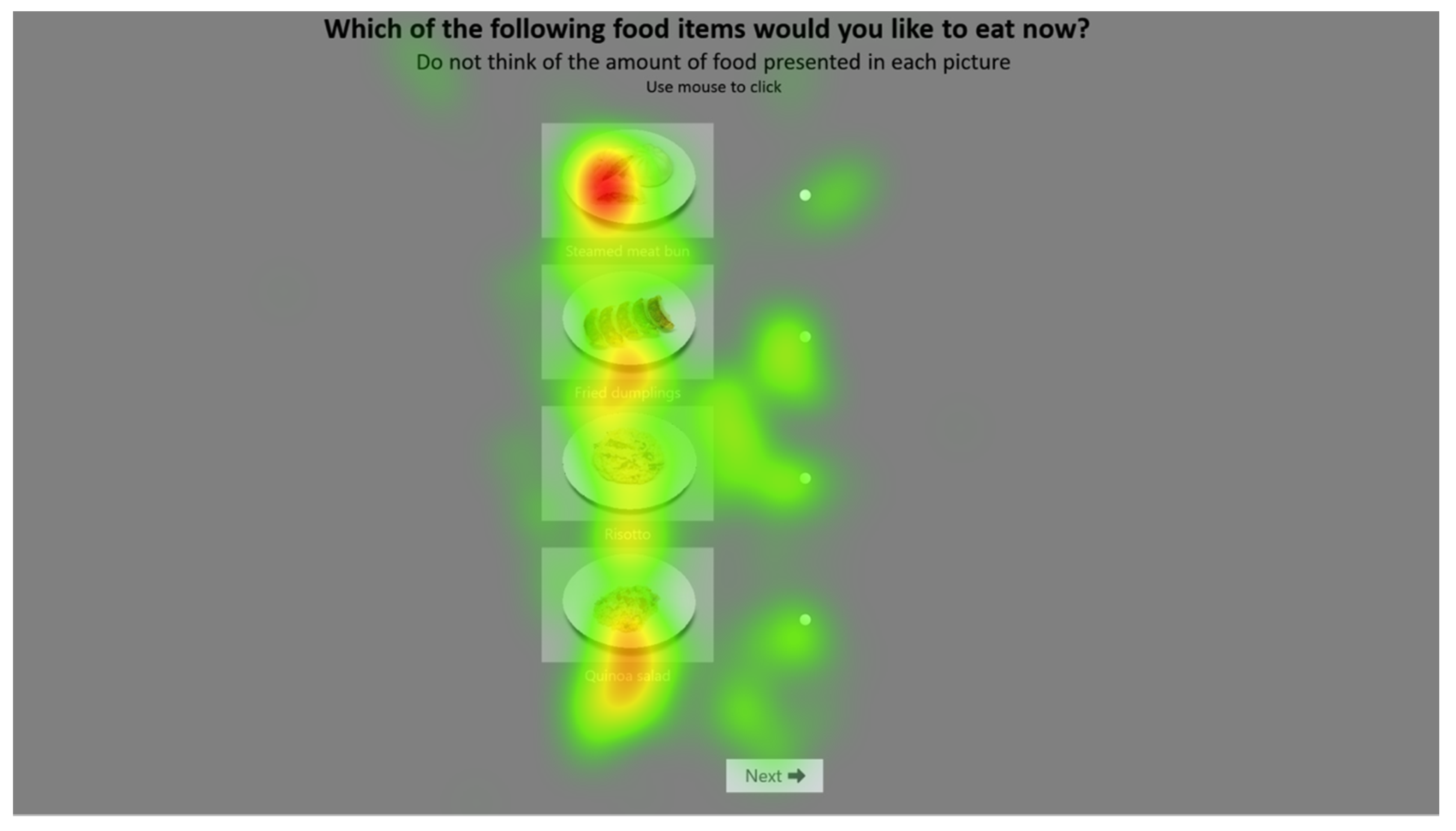
References
- Krishna, A. An integrative review of sensory marketing: Engaging the senses to affect perception, judgment and behavior. J. Consum. Psychol. 2012, 22, 332–351. [Google Scholar] [CrossRef]
- Krishna, A.; Cian, L.; Sokolova, T. The power of sensory marketing in advertising. Curr. Opin. Psychol. 2016, 10, 142–147. [Google Scholar] [CrossRef]
- Spence, C. Gastrophysics-The New Science of Eating; Penguin Books Ltd.: Harmondsworth, UK, 2012; ISBN 9780241977743. [Google Scholar]
- Seo, H.-S. Sensory Nudges: The Influences of Environmental Contexts on Consumers’ Sensory Perception, Emotional Responses, and Behaviors toward Foods and Beverages. Foods 2020, 9, 509. [Google Scholar] [CrossRef] [PubMed]
- Spence, C. Simple and complex crossmodal correspondences involving audition. Acoust. Sci. Technol. 2020, 41, 6–12. [Google Scholar] [CrossRef]
- Kantono, K.; Hamid, N.; Shepherd, D.; Yoo, M.J.Y.; Carr, B.T.; Grazioli, G. The effect of background music on food pleasantness ratings. Psychol. Music 2016, 44, 1111–1125. [Google Scholar] [CrossRef]
- Milliman, R.E. The Influence of Background Music on the Behavior of Restaurant Patrons. J. Consum. Res. 1986, 13, 286. [Google Scholar] [CrossRef]
- Poupis, L.M. Wishful hearing: The effect of chronic dieting on auditory perceptual biases and eating behavior. Appetite 2018, 130, 219–227. [Google Scholar] [CrossRef]
- Wang, Q.J.; Woods, A.T.; Spence, C. “What’s Your Taste in Music?” A Comparison of the Effectiveness of Various Soundscapes in Evoking Specific Tastes. Iperception. 2015, 6. [Google Scholar] [CrossRef] [PubMed]
- Milliman, R.E. Using Background Music to Affect the Behavior of Supermarket Shoppers. J. Mark. 1982, 46, 86. [Google Scholar] [CrossRef]
- Zellner, D.; Geller, T.; Lyons, S.; Pyper, A.; Riaz, K. Ethnic congruence of music and food affects food selection but not liking. Food Qual. Prefer. 2017, 56, 126–129. [Google Scholar] [CrossRef]
- Biswas, D.; Lund, K.; Szocs, C. Sounds like a healthy retail atmospheric strategy: Effects of ambient music and background noise on food sales. J. Acad. Mark. Sci. 2019, 47, 37–55. [Google Scholar] [CrossRef]
- Reinoso-Carvalho, F.; Gunn, L.; Molina, G.; Narumi, T.; Spence, C.; Suzuki, Y.; Horst, E.; Wagemans, J. A sprinkle of emotions vs a pinch of crossmodality: Towards globally meaningful sonic seasoning strategies for enhanced multisensory tasting experiences. J. Bus. Res. 2020, 117, 389–399. [Google Scholar] [CrossRef]
- Mathiesen, S.L.; Mielby, L.A.; Byrne, D.V.; Wang, Q.J. A systematic investigation of the relative importance of tempo and articulation on eating time. Appetite 2020, in press. [Google Scholar] [CrossRef] [PubMed]
- Zhu, R.; Meyers-Levy, J. Distinguishing between the Meanings of Music: When Background Music Affects Product Perceptions. J. Mark. Res. 2005, 42, 333–345. [Google Scholar] [CrossRef]
- Areni, C.S.; Kim, D. The Influence of Background Music on Shopping Behavior: Classical Versus Top-Forty Music in a Wine Store. Adv. Consum. Res. 1993, 20, 336–340. [Google Scholar]
- North, A.C.; Shilcock, A.; Hargreaves, D.J. The Effect of Musical Style on Restaurant Customers’ Spending. Environ. Behav. 2003, 35, 712–718. [Google Scholar] [CrossRef]
- North, A.C.; Hargreaves, D.J.; McKendrick, J. Influence of in-store music on wine selection. J. Appl. Psychol. 1999, 84, 271–276. [Google Scholar] [CrossRef]
- Rangel, A.; Camerer, C.; Montague, P.R. A framework for studying the neurobiology of value-based decision making. Nat. Rev. Neurosci. 2008, 9, 545–556. [Google Scholar] [CrossRef]
- Chen, R.; Peng-Li, D.; Turel, O.; Sørensen, T.A.; Bechara, A.; Li, Y.; He, Q. Decision Making Deficits in Relation to Food Cues Influence Obesity: A Triadic Neural Model of Problematic Eating. Front. Psychiatry 2018, 9, 264. [Google Scholar] [CrossRef]
- Knoferle, K.M.; Spangenberg, E.R.; Herrmann, A.; Landwehr, J.R. It is all in the mix: The interactive effect of music tempo and mode on in-store sales. Mark. Lett. 2012, 23, 325–337. [Google Scholar] [CrossRef]
- Helmefalk, M.; Hultén, B. Multi-sensory congruent cues in designing retail store atmosphere: Effects on shoppers’ emotions and purchase behavior. J. Retail. Consum. Serv. 2017, 38, 1–11. [Google Scholar] [CrossRef]
- Cowen, A.S.; Fang, X.; Sauter, D.; Keltner, D. What music makes us feel: At least 13 dimensions organize subjective experiences associated with music across different cultures. Proc. Natl. Acad. Sci. USA 2020, 117, 1924–1934. [Google Scholar] [CrossRef] [PubMed]
- North, A.C.; Sheridan, L.P.; Areni, C.S. Music Congruity Effects on Product Memory, Perception, and Choice. J. Retail. 2016, 92, 83–95. [Google Scholar] [CrossRef]
- Herget, A.-K.; Breves, P.; Schramm, H. The Influence of Different Levels of Musical Fit on the Efficiency of Audio-Visual Advertising. Music. Sci. 2020, 102986492090409. [Google Scholar] [CrossRef]
- Yeoh, J.P.S.; North, A.C. The effects of musical fit on choice between two competing foods. Music. Sci. 2010, 14, 165–180. [Google Scholar] [CrossRef]
- Chiu, L.-H. A Cross-Cultural Comparison of Cognitive Styles in Chinese and American Children. Int. J. Psychol. 1972, 7, 235–242. [Google Scholar] [CrossRef]
- Goh, J.O.; Tan, J.C.; Park, D.C. Culture Modulates Eye-Movements to Visual Novelty. PLoS ONE 2009, 4, e8238. [Google Scholar] [CrossRef]
- Shankar, M.U.; Levitan, C.A.; Spence, C. Grape expectations: The role of cognitive influences in color–flavor interactions. Conscious. Cogn. 2010, 19, 380–390. [Google Scholar] [CrossRef]
- Zhang, Q.; Elsweiler, D.; Trattner, C. Visual Cultural Biases in Food Classification. Foods 2020, 9, 823. [Google Scholar] [CrossRef]
- Kantono, K.; Hamid, N.; Shepherd, D.; Lin, Y.H.T.; Skiredj, S.; Carr, B.T. Emotional and electrophysiological measures correlate to flavour perception in the presence of music. Physiol. Behav. 2019, 199, 154–164. [Google Scholar] [CrossRef]
- Gunaratne, T.M.; Fuentes, S.; Gunaratne, N.M.; Torrico, D.D.; Gonzalez Viejo, C.; Dunshea, F.R. Physiological Responses to Basic Tastes for Sensory Evaluation of Chocolate Using Biometric Techniques. Foods 2019, 8, 243. [Google Scholar] [CrossRef] [PubMed]
- Piqueras-Fiszman, B.; Velasco, C.; Salgado-Montejo, A.; Spence, C. Using combined eye tracking and word association in order to assess novel packaging solutions: A case study involving jam jars. Food Qual. Prefer. 2013, 28, 328–338. [Google Scholar] [CrossRef]
- Day, R.-F.; Lin, C.-H.; Huang, W.-H.; Chuang, S.-H. Effects of music tempo and task difficulty on multi-attribute decision-making: An eye-tracking approach. Comput. Hum. Behav. 2009, 25, 130–143. [Google Scholar] [CrossRef]
- Motoki, K.; Saito, T.; Nouchi, R.; Kawashima, R.; Sugiura, M. Tastiness but not healthfulness captures automatic visual attention: Preliminary evidence from an eye-tracking study. Food Qual. Prefer. 2018, 64, 148–153. [Google Scholar] [CrossRef]
- Zhang, B.; Seo, H.-S. Visual attention toward food-item images can vary as a function of background saliency and culture: An eye-tracking study. Food Qual. Prefer. 2015, 41, 172–179. [Google Scholar] [CrossRef]
- Peng-Li, D.; Byrne, D.V.; Chan, R.C.K.; Wang, Q.J. The influence of taste-congruent soundtracks on visual attention and food choice: A cross-cultural eye-tracking study in Chinese and Danish consumers. Food Qual. Prefer. 2020, 85, 103962. [Google Scholar] [CrossRef]
- Schotter, E.R.; Berry, R.W.; McKenzie, C.R.M.; Rayner, K. Gaze bias: Selective encoding and liking effects. Vis. Cogn. 2010, 18, 1113–1132. [Google Scholar] [CrossRef]
- Toet, A.; Kaneko, D.; de Kruijf, I.; Ushiama, S.; van Schaik, M.G.; Brouwer, A.-M.; Kallen, V.; van Erp, J.B.F. CROCUFID: A Cross-Cultural Food Image Database for Research on Food Elicited Affective Responses. Front. Psychol. 2019, 10, 58. [Google Scholar] [CrossRef]
- Majaranta, P.; Aoki, H.; Donegan, M.; Hansen, D.W.; Hansen, J.P.; Hyrskykari, A.; Räihä, K.-J. Gaze Interaction and Applications of Eye Tracking; IGI Global: Hershey, PA, USA, 2012; ISBN 9781613500989. [Google Scholar]
- Kontukoski, M.; Luomala, H.; Mesz, B.; Sigman, M.; Trevisan, M.; Rotola-Pukkila, M.; Hopia, A.I. Sweet and sour: Music and taste associations. Nutr. Food Sci. 2015, 45, 357–376. [Google Scholar] [CrossRef]
- Wang, Q.J.; Spence, C. Assessing the Effect of Musical Congruency on Wine Tasting in a Live Performance Setting. Iperception 2015, 6. [Google Scholar] [CrossRef]
- Duerlund, M.; Andersen, B.V.; Alexi, N.; Peng, M.; Byrne, D.V. Subjective Sensations related to Food as Determinants of Snack Choice. Foods 2020, 9, 336. [Google Scholar] [CrossRef] [PubMed]
- Frank, S.; Laharnar, N.; Kullmann, S.; Veit, R.; Canova, C.; Hegner, Y.L.; Fritsche, A.; Preissl, H. Processing of food pictures: Influence of hunger, gender and calorie content. Brain Res. 2010, 1350, 159–166. [Google Scholar] [CrossRef] [PubMed]
- iMotions® Eye Tracking The Complete Pocket Guide. Available online: https://imotions.com/blog/eye-tracking/ (accessed on 30 June 2020).
- Orquin, J.L.; Loose, S.M. Attention and choice: A review on eye movements in decision making. Acta Psychol. (Amst.) 2013, 144, 190–206. [Google Scholar] [CrossRef] [PubMed]
- Kliegl, R. Toward a perceptual-span theory of distributed processing in reading: A reply to Rayner, Pollatsek, Drieghe, Slattery, and Reichle. J. Exp. Psychol. Gen. 2007, 136, 530–537. [Google Scholar] [CrossRef]
- Hohenstein, S.; Matuschek, H.; Kliegl, R. Linked linear mixed models: A joint analysis of fixation locations and fixation durations in natural reading. Psychon. Bull. Rev. 2017, 24, 637–651. [Google Scholar] [CrossRef] [PubMed]
- Yan, M.; Zhou, W.; Shu, H.; Yusupu, R.; Miao, D.; Krügel, A.; Kliegl, R. Eye movements guided by morphological structure: Evidence from the Uighur language. Cognition 2014, 132, 181–215. [Google Scholar] [CrossRef] [PubMed]
- Orquin, J.; Holmqvist, K. A Primer on Eye Tracking Methodology for Behavioral Sciences. In A Handbook of Process Tracing Methods; Routledge: Abingdon, UK, 2019. [Google Scholar]
- Orquin, J.L.; Holmqvist, K. Threats to the validity of eye-movement research in psychology. Behav. Res. Methods 2018, 50, 1645–1656. [Google Scholar] [CrossRef] [PubMed]
- Midi, H.; Sarkar, S.K.; Rana, S. Collinearity diagnostics of binary logistic regression model. J. Interdiscip. Math. 2010, 13, 253–267. [Google Scholar] [CrossRef]
- Spence, C.; Puccinelli, N.M.; Grewal, D.; Roggeveen, A.L. Store Atmospherics: A Multisensory Perspective. Psychol. Mark. 2014, 31, 472–488. [Google Scholar] [CrossRef]
- Manippa, V.; van der Laan, L.N.; Brancucci, A.; Smeets, P.A.M. Health body priming and food choice: An eye tracking study. Food Qual. Prefer. 2019, 72, 116–125. [Google Scholar] [CrossRef]
- Gidlöf, K.; Dewhurst, R.; Holmqvist, K.; Wallin, A. Using Eye Tracking to Trace a Cognitive Process: Gaze Behaviour During Decision Making in a Natural Environment. J. Eye Mov. Res. 2013, 6, 1–14. [Google Scholar]
- Peschel, A.O.; Orquin, J.L.; Mueller Loose, S. Increasing consumers’ attention capture and food choice through bottom-up effects. Appetite 2019, 132, 1–7. [Google Scholar] [CrossRef] [PubMed]
- Van der Laan, L.N.; Hooge, I.T.C.; de Ridder, D.T.D.; Viergever, M.A.; Smeets, P.A.M. Do you like what you see? The role of first fixation and total fixation duration in consumer choice. Food Qual. Prefer. 2015, 39, 46–55. [Google Scholar] [CrossRef]
- Wang, E.; Cakmak, Y.O.; Peng, M. Eating with eyes—Comparing eye movements and food choices between overweight and lean individuals in a real-life buffet setting. Appetite 2018, 125, 152–159. [Google Scholar] [CrossRef]
- Reale, S.; Flint, S.W. The Impact of Menu Label Design on Visual Attention, Food Choice and Recognition: An Eye Tracking Study. J. Sens. Stud. 2016, 31, 328–340. [Google Scholar] [CrossRef]
- Chua, H.F.; Boland, J.E.; Nisbett, R.E. From The Cover: Cultural variation in eye movements during scene perception. Proc. Natl. Acad. Sci. USA 2005, 102, 12629–12633. [Google Scholar] [CrossRef] [PubMed]
- Masuda, T.; Wang, H.; Ishii, K.; Ito, K. Do surrounding figures’ emotions affect judgment of the target figure’s emotion? Comparing the eye-movement patterns of European Canadians, Asian Canadians, Asian international students, and Japanese. Front. Integr. Neurosci. 2012, 6. [Google Scholar] [CrossRef]
- Barrett, H.C. Towards a Cognitive Science of the Human: Cross-Cultural Approaches and Their Urgency. Trends Cogn. Sci. 2020. [Google Scholar] [CrossRef]
- Nisbett, R.E.; Miyamoto, Y. The influence of culture: Holistic versus analytic perception. Trends Cogn. Sci. 2005, 9, 467–473. [Google Scholar] [CrossRef]
- Evans, J.S.B.T. On the resolution of conflict in dual process theories of reasoning. Think. Reason. 2007, 13, 321–339. [Google Scholar] [CrossRef]
- Peng-Li, D.; Sørensen, T.A.; Li, Y.; He, Q. Lower structural brain connectivity in individuals with elevated food addiction symptoms. Appetite. under review.
- Hunter, J.A.; Hollands, G.J.; Couturier, D.-L.; Marteau, T.M. Effect of snack-food proximity on intake in general population samples with higher and lower cognitive resource. Appetite 2018, 121, 337–347. [Google Scholar] [CrossRef] [PubMed]
- Marques, I.C.F.; Ting, M.; Cedillo-mart, D.; Federico, J.A.P. Effect of Impulsivity Traits on Food Choice within a Nudging Intervention. Nutrients. 2020, 12, 1402. [Google Scholar] [CrossRef] [PubMed]
- Zhou, J.X.; Arnold, M.J.; Pereira, A.; Yu, J. Chinese consumer decision-making styles: A comparison between the coastal and inland regions. J. Bus. Res. 2010, 63, 45–51. [Google Scholar] [CrossRef]
- Qian, S. Chinese Culture; WORLD SCIENTIFIC (EUROPE): Hackensac, NJ, USA, 2020; ISBN 978-1-78634-899-9. [Google Scholar]
- Ares, G. Methodological issues in cross-cultural sensory and consumer research. Food Qual. Prefer. 2018, 64, 253–263. [Google Scholar] [CrossRef]
- Xu, Y.; Hamid, N.; Shepherd, D.; Kantono, K.; Reay, S.; Martinez, G.; Spence, C. Background soundscapes influence the perception of ice-cream as indexed by electrophysiological measures. Food Res. Int. 2019, 125, 108564. [Google Scholar] [CrossRef]
- Salimpoor, V.N.; Benovoy, M.; Larcher, K.; Dagher, A.; Zatorre, R.J. Anatomically distinct dopamine release during anticipation and experience of peak emotion to music. Nat. Neurosci. 2011, 14, 257–262. [Google Scholar] [CrossRef]
- Spence, C.; Gallace, A. Multisensory design: Reaching out to touch the consumer. Psychol. Mark. 2011, 28, 267–308. [Google Scholar] [CrossRef]
- Just, M.A.; Carpenter, P.A. Eye fixations and cognitive processes. Cogn. Psychol. 1976, 8, 441–480. [Google Scholar] [CrossRef]
- Olsen, A. The Tobii I-VT Fixation Filter-Algorithm Description. Available online: http://www.vinis.co.kr/ivt_filter.pdf (accessed on 2 August 2020).
- Pashler, H.; Wagenmakers, E. Editors’ Introduction to the Special Section on Replicability in Psychological Science. Perspect. Psychol. Sci. 2012, 7, 528–530. [Google Scholar] [CrossRef]
- Fanelli, R.M.; Di Nocera, A. Customer perceptions of Japanese foods in Italy. J. Ethn. Foods 2018, 5, 167–176. [Google Scholar] [CrossRef]
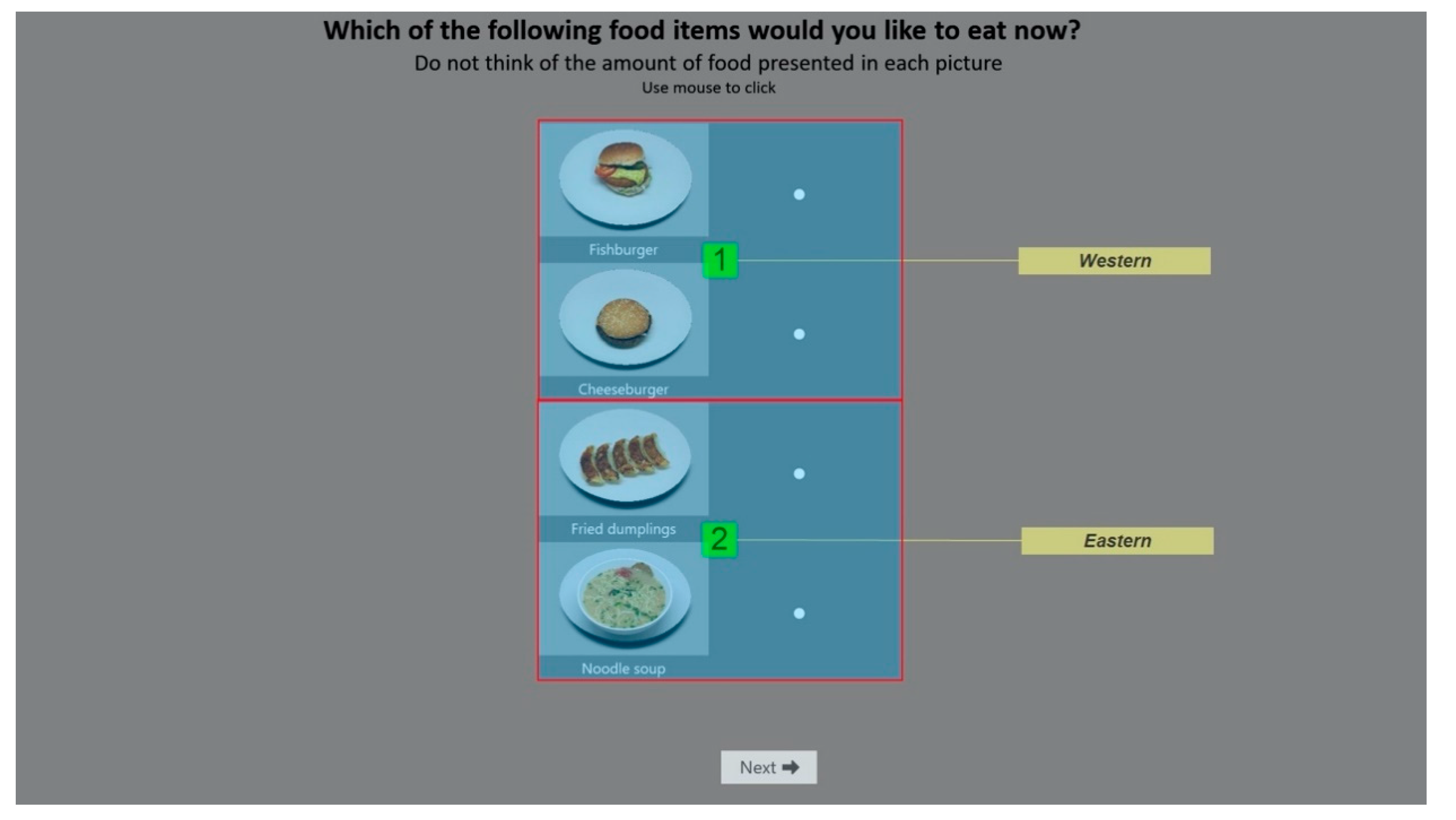
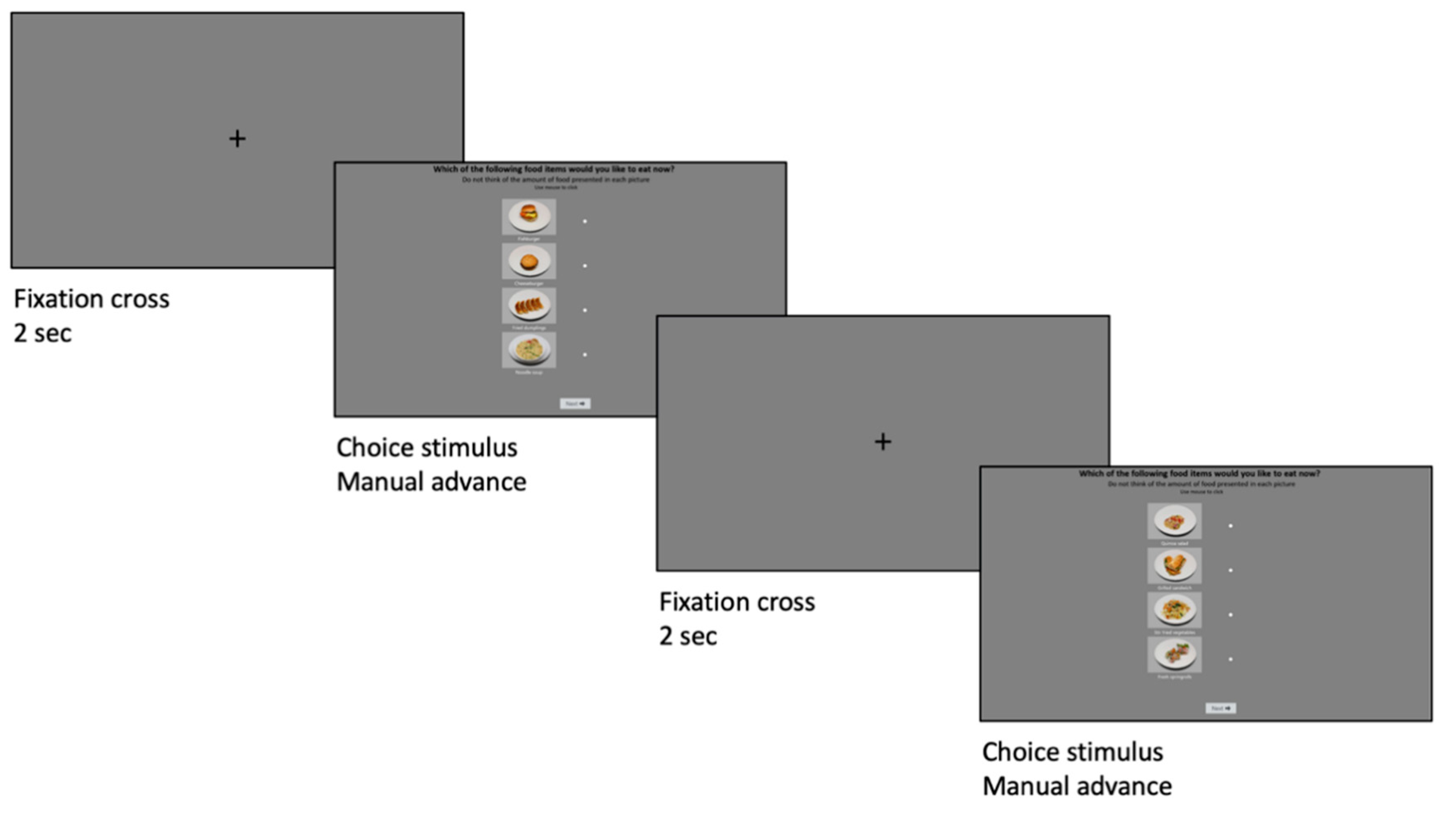
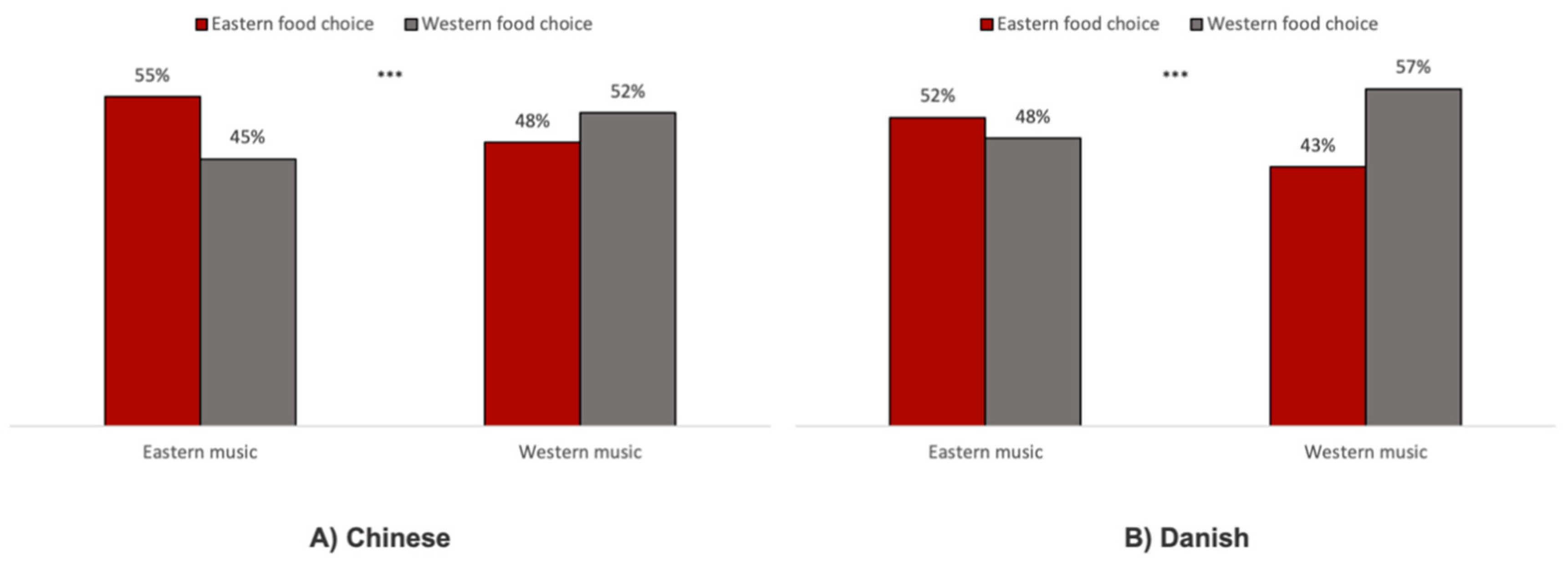
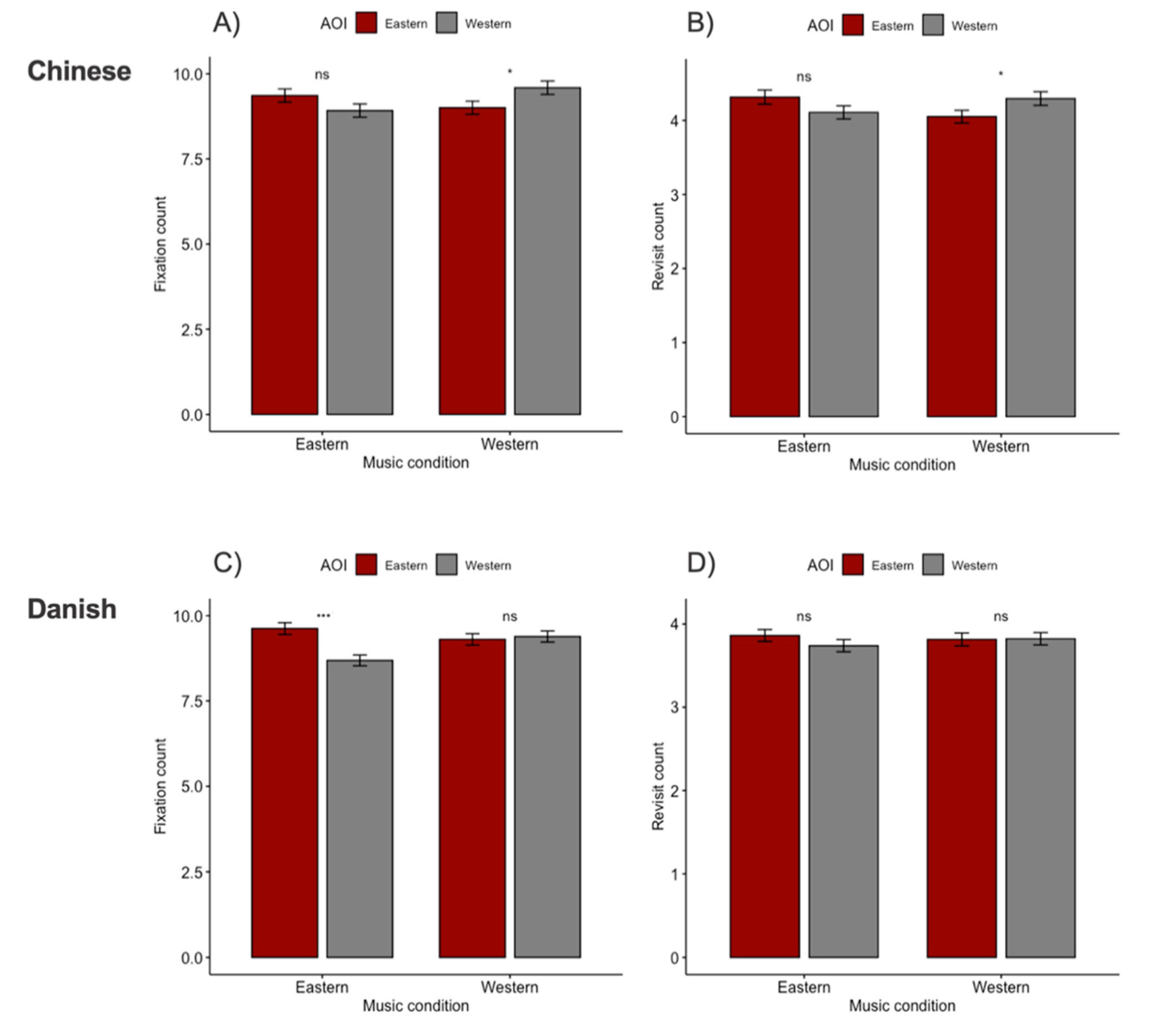

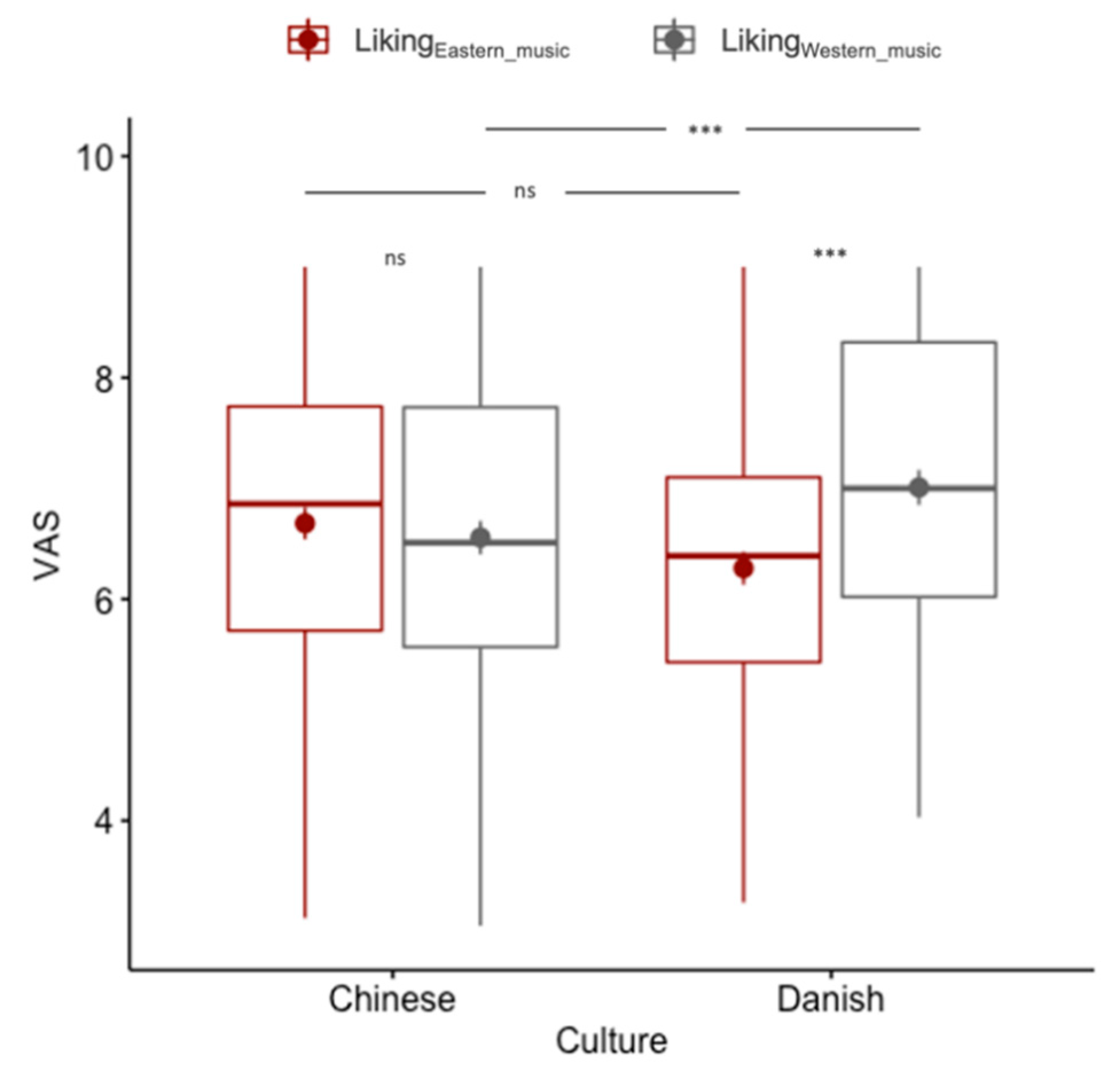
| Fixation Count | Revisit Count | |
|---|---|---|
| Chinese and Danish participants (N = 193) | ||
| Culture | p > 0.100 | p > 0.100 |
| Music | p > 0.100 | p > 0.100 |
| AOI | z(7710) = −3.20; p = 0.001 ** | z(7710) = −2.21; p = 0.027 * |
| Culture × Music | p > 0.100 | p > 0.100 |
| Culture × AOI | z(7710) = −2.52; p = 0.012 * | p > 0.100 |
| Music × AOI | z(7710) = 5.25; p < 0.001 *** | z(7710) = 3.41; p < 0.001 *** |
| Culture × Music × AOI | p > 0.100 | p > 0.100 |
| Chinese participants (n = 96) | ||
| Music | p > 0.100 | p > 0.100 |
| AOI | z(3834) = −3.20; p = 0.001 ** | z(3834) = −2.20; p = 0.027 * |
| Music × AOI | z(3834) = 5.25; p < 0.001 *** | z(3834) = 3.41; p < 0.001 *** |
| Danish participants (n = 97) | ||
| Music | p > 0.100 | p > 0.100 |
| AOI | z(3874) = 6.76; p < 0.001 *** | p > 0.100 |
| Music × AOI | z(3874) = 5.26; p < 0.001 *** | p > 0.100 |
| β | S.E. | Wald’s z | df | p | 95% CI | |
|---|---|---|---|---|---|---|
| Chinese participants (n = 96) | ||||||
| (Intercept) | −2.07 | 0.12 | −17.04 | 3834 | <0.001 | [−2.31–1.84] |
| Fixation count | 0.25 | 0.01 | 17.87 | 3834 | <0.001 *** | [0.22–0.28] |
| Revisit count | −0.05 | 0.02 | −1.98 | 3834 | 0.048 * | [−0.10–0.01] |
| Danish participants (n = 97) | ||||||
| (Intercept) | −2.01 | 0.11 | −17.62 | 3874 | <0.001 | [−2.24–1.79] |
| Fixation count | 0.26 | 0.01 | 18.83 | 3874 | <0.001 *** | [0.23–0.29] |
| Revisit count | −0.10 | 0.03 | −3.95 | 3874 | <0.001 *** | [−0.15–0.05] |
© 2020 by the authors. Licensee MDPI, Basel, Switzerland. This article is an open access article distributed under the terms and conditions of the Creative Commons Attribution (CC BY) license (http://creativecommons.org/licenses/by/4.0/).
Share and Cite
Peng-Li, D.; Chan, R.C.K.; Byrne, D.V.; Wang, Q.J. The Effects of Ethnically Congruent Music on Eye Movements and Food Choice—A Cross-Cultural Comparison between Danish and Chinese Consumers. Foods 2020, 9, 1109. https://doi.org/10.3390/foods9081109
Peng-Li D, Chan RCK, Byrne DV, Wang QJ. The Effects of Ethnically Congruent Music on Eye Movements and Food Choice—A Cross-Cultural Comparison between Danish and Chinese Consumers. Foods. 2020; 9(8):1109. https://doi.org/10.3390/foods9081109
Chicago/Turabian StylePeng-Li, Danni, Raymond C. K. Chan, Derek V. Byrne, and Qian Janice Wang. 2020. "The Effects of Ethnically Congruent Music on Eye Movements and Food Choice—A Cross-Cultural Comparison between Danish and Chinese Consumers" Foods 9, no. 8: 1109. https://doi.org/10.3390/foods9081109
APA StylePeng-Li, D., Chan, R. C. K., Byrne, D. V., & Wang, Q. J. (2020). The Effects of Ethnically Congruent Music on Eye Movements and Food Choice—A Cross-Cultural Comparison between Danish and Chinese Consumers. Foods, 9(8), 1109. https://doi.org/10.3390/foods9081109






